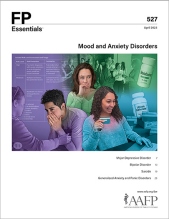
This clinical content conforms to AAFP criteria for CME.
In the United States, suicide was the cause of more than 47,500 deaths in 2019. Females attempt suicide 1.5 times more frequently than males. However, rates of completed suicide are higher in males than in females. In the US population, the suicide rate is highest in adults older than 75 years. Factors associated with an increased risk of suicide include geographic and social isolation, low access to clinical resources, unemployment, and poverty. Patients with mental disorders, including schizophrenia, major depressive disorder (MDD), bipolar disorder, and substance use disorder, are at increased risk. Directly questioning a patient about suicide has not been shown to increase the patient’s risk of completing suicide. Physicians should ask patients about any suicide plans and details of timing, location, means, and any preparation for the act. The goal of pharmacotherapy in patients with suicidality is management of comorbid mood disorders, most often MDD. Esketamine nasal spray is a pharmacotherapy option for MDD management in patients with acute suicidal ideation or behavior. It is approved for use in conjunction with an oral antidepressant. Use of “no harm contracts” or “safety contracts,” in which patients attest that they will not commit suicide, should not be relied on to the exclusion of a formal suicide risk assessment and thorough clinical evaluation.
Case 3. ZT is a 28-year-old transgender man who comes to your office for evaluation of urinary tract infection (UTI) symptoms. He has a history of anorexia nervosa. When you enter the room, he makes little eye contact. After addressing the UTI symptoms, you ask ZT how else you can help him today. ZT responds, “I don’t know if you can. My life is not worth living anymore and I need to end this pain.”
Subscribe
From $350- Immediate, unlimited access to FP Essentials content
- 60 CME credits/year
- AAFP app access
- Print delivery available
Edition Access
$44- Immediate, unlimited access to this edition's content
- 5 CME credits
- AAFP app access
- Print delivery available
